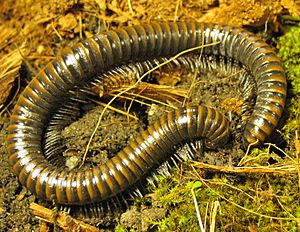Paeromopus facts for kids
Quick facts for kids Paeromopus |
|
|---|---|
 |
|
| Paeromopus angusticeps | |
| Scientific classification | |
| Kingdom: | |
| Phylum: | |
| Subphylum: | |
| Class: | |
| Order: |
Julida
|
| Family: | |
| Genus: |
Paeromopus
Karsch, 1881
|
| Type species | |
| Paeromopus angusticeps Wood, 1864
|
|
| Species | |
|
|
| Synonyms | |
|
Paeromopellus Verhoeff, 1938 |
|
Paeromopus is a group of very long, tube-shaped millipedes. They are only found in the state of California, USA. These millipedes are quite big! All of them are longer than 10 centimeters (4 inches). The longest one, called P. paniculus, can grow up to 16.5 centimeters (6.5 inches). That makes it the longest millipede species in all of North America! A German scientist named Ferdinand Karsch first named this group in 1881. There are four known species of Paeromopus. Three species live in small areas of the Sierra Nevada mountains. One species lives in a much larger area, including the Sierra Nevada and parts of Northern California all the way to the Central Coast.
What Do Paeromopus Look Like?
Paeromopus millipedes are long and shaped like a cylinder. They measure from 10 to 16.5 centimeters (4 to 6.5 inches) long. They can be up to 8 millimeters (0.3 inches) wide. These millipedes have many body segments, usually between 68 and 80.
Most Paeromopus are brown to black. They often have bands of light brown or yellow. Some can be dark gray or bluish gray with faint bands. Their legs are quite long. However, the first pair of legs on males is very small. Like other millipedes in their family, Paeromopus have tiny parallel grooves on each body segment. These grooves make them look a bit rough.
Their simple eyes, called ocelli, are on each side of their head. Each eye patch can have up to 31 ocelli. These eyes are not all the same size and are arranged in rows.
Where Do Paeromopus Live?
There are four different species of Paeromopus millipedes.
The species P. angusticeps has the largest home range. It lives across much of Northern California. You can find it in a big arc from Monterey County on the central coast. It goes north along the Coast Ranges to Humboldt County. Then it goes down along the Cascades and Sierra Nevada mountains in eastern California.
The other three species are found in much smaller areas. They all live within the Sierra Nevada mountains.
| Species Name | Scientist Who Named It | Where It Lives |
|---|---|---|
| P. angusticeps | (Wood, 1864) | Most of Northern California, but not much in the Central Valley. Found from Humboldt County to Monterey County along the Coast Ranges. Also from Shasta County to Tuolumne County along the Cascades and Sierra Nevada mountains. |
| P. cavicolens | Chamberlin, 1949 | Tuolumne County |
| P. eldoradus | Chamberlin, 1941 | El Dorado County |
| P. paniculus | Shelley & Bauer, 1997 | Mariposa County |
How Scientists Name and Classify Them
The group Paeromopus was first named in 1881 by a German scientist named Ferdinand Karsch. However, the very first species now in this group, P. angusticeps, was described earlier. In 1864, an American scientist named Horatio C Wood described it. He called it Spirobolus angusticeps from specimens found in San Francisco.
In 1881, Karsch described a new species he named Paeromopus lysiopetalinus. This was the first time the name "Paeromopus" was used for a genus. Later, in 1949, another scientist, Ralph V. Chamberlin, realized that Wood's S. angusticeps actually belonged in the Paeromopus group. So, he renamed it P. angusticeps.
Eventually, scientists found that P. lysiopetalinus was the same species as P. angusticeps. When two different names are given to the same species, the older name is usually kept. This is called a taxonomic synonym.
Today, Paeromopus is known to be part of the family Paeromopodidae. This family belongs to the order Julida. The original genus Wood used, Spirobolus, is in a different family and order.
Scientists have described more species in the Paeromopodidae family over time. Some species that were once named separately were later found to be the same as older ones. Others were moved to a similar group called Californiulus. The newest species described in the Paeromopus group was P. paniculus in 1997.
Karsch did not explain what the name Paeromopus means. However, the ending -pus usually refers to legs.

